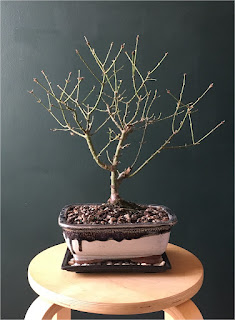Bonsai is the marvelous art of growing a miniature replica of a tree. Many connoisseurs of indoor plants have already managed to join this skill. But before you buy or plant a dwarf tree from scratch, you should find out about all the nuances associated with caring for a plant at different times of the year, especially in winter.
What happens to the plant in winter?
Bonsai in winter requires especially anxious care, since from the end of autumn the tree gradually sinks into a state of dormancy. Improper care during this period can provoke a violation of the biological cycle, which we can observe in natural forests.
Daylight hours are gradually minimized and the temperature regime is changing. Therefore, it is necessary to create indoor conditions as close as possible to the natural climate.
Trees growing in tropical areas winter relatively well in a home environment. They are less whimsical and continue to grow even at room temperature. The rest period for them is forced.
It is important for plants in subtropical forests to provide an appropriate temperature and air flow. This ensures that they are properly resting until the next growth cycle, which begins with the arrival of spring.
How to care for coniferous bonsai in winter?
The most important rule for keeping coniferous bonsai (pine, spruce, thuja, etc.) is to create a harmonious temperature regime. The most preferred temperature for it varies from +5 to +10 degrees. It is allowed to lower it to zero, but not lower. Still, the plant was originally grown in greenhouse conditions, which means that a significant deviation from it can lead to partial or complete freezing the of bonsai root system.
The glazed loggia is an ideal place for wintering a coniferous tree. If there is no balcony, place the bonsai between or close to window frames.

When the temperature in the room exceeds 10 - 15 degrees, it is necessary to carefully monitor the moisture content of the earth, to prevent the soil from drying out. This will require:
Irrigate the plant 4 - 5 times (if there is moss decoration at the bottom - completely moisten the surface);
water when the upper layer of the earth dries up.
In addition, provide bright lighting and continuous circulation of fresh air for coniferous bonsai, especially for trees such as pine and juniper.
For feeding, use a complex fertilizer (according to the instructions). The procedure should be performed in November and February 2 times a month. In December and January, the plant can not be fed, and since March, apply fertilizer weekly.
Winter care of deciduous bonsai
The most unpretentious type of bonsai; in comparison with the rest, these are evergreen trees. They tolerate winter well, but there are certain recommendations for growing such plants:

- daily watering, drying out of the soil should not be allowed even for one day;
- spraying is carried out 2 - 3 times a day;
- there should be as much light as possible in the room where the plant is kept;
- feed with mineral fertilizer twice a month .
The deciduous bonsai is different from all miniature tree varieties. In the fall, the plant goes into a dormant state and the bonsai sheds its leaves. Graceful plexus of thin branches look no less impressive in the interior, and can delight any avid plant grower with their appearance.
Care Tips for Deciduous Bonsai:
- water as needed (only when the topsoil dries up);
- the temperature should be below average (10 - 15 degrees);
- moderate lighting;
- feeding is not required.
In the period from October to January, the tree rests and prepares for a new cycle of active growth. In February, the plant wakes up slowly, so it should be moved to a lighter and warmer place. After the first leaves begin to sprout, it is recommended to start regular watering and fertilize with a frequency of 2 - 3 times a month.
Which bonsai trees winter well at home?
To avoid unsuccessful attempts at growing dwarf trees, choose varieties that grow in rainforests or in the local area of your region.
The most suitable varieties for indoor bonsai:
- ficus;
- mandarin;
- Garnet;
- maple;
- sequoia;
- cotoneaster;
- boxwood;
- muraya;
- cypress;
- thuja;
- cryptomeria;


.jpeg)


0 Comments
Post a Comment